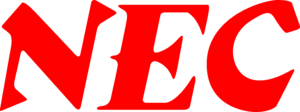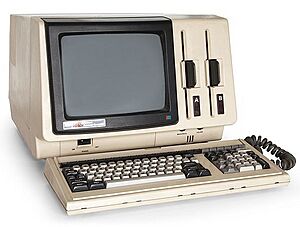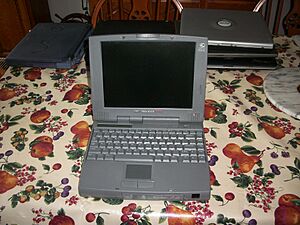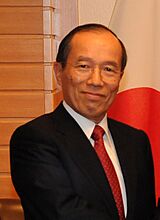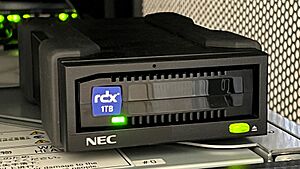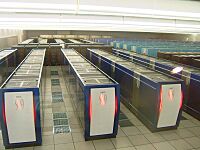NEC facts for kids

Logo since 1992
|
|

Headquarters at the NEC Supertower in Minato, Tokyo, Japan
|
|
|
Native name
|
日本電気株式会社
|
|---|---|
|
Romanized name
|
Nippon Denki Kabushiki gaisha |
|
Formerly
|
Nippon Electric Company, Limited (1899-1983, in English) |
| Public | |
| Traded as | TYO: 6701 |
| ISIN | JP3733000008 |
| Industry |
|
| Founded | 17 July 1899 in Tokyo, Japan |
| Headquarters | NEC Supertower,
,
Japan
|
|
Area served
|
Worldwide |
|
Key people
|
|
| Products |
Former
|
| Services | |
| Revenue | ¥3.48 trillion (2024) |
|
Operating income
|
¥185.01 billion (2024) |
| ¥149.52 billion (2024) | |
| Total assets | ¥4.23 trillion (2024) |
| Total equity | ¥2.09 trillion (2024) |
| Owner | AT&T Corporation (via Western Electric, 1899-1941) Sumitomo Group |
|
Number of employees
|
105,246 (2024) |
| Subsidiaries |
List
NEC Platforms
NEC Fielding NEC Solution Innovators ABeam Consulting NEC Communication Systems NEC Nexsolutions NEC Facilities NEC Networks & System Integration (51.4%) Japan Aviation Electronics (50.8%) NEC Corporation of America NEC Europe NEC Asia Pacific NEC China NEC Latin America Netcracker Technology |
NEC Corporation (日本電気株式会社, Nippon Denki Kabushiki gaisha, an acronym for the Nippon Electric Company) is a big Japanese company. It works with information technology and electronics. Its main office is in the NEC Supertower in Minato, Tokyo, Japan.
NEC creates IT and network solutions for businesses, phone companies, and governments. These solutions include cloud computing, artificial intelligence (AI), and Internet of Things (IoT) platforms. They also make telecommunications equipment and software. NEC has been the top PC seller in Japan since the 1980s. Today, it runs its PC business in Japan with Lenovo.
NEC was once one of the world's biggest makers of semiconductors (tiny electronic parts). It was also a major electronics company in Japan. NEC is part of the Sumitomo Group, a large group of companies.
Contents
History of NEC
How NEC Started
Kunihiko Iwadare and Takeshiro Maeda started Nippon Electric Limited Partnership on August 31, 1898. They used buildings they bought from another company. An American company called Western Electric was interested in the Japanese phone market. They helped set up the new company.
On July 17, 1899, the company became Nippon Electric Company, Limited. It was the first Japanese company to have foreign money invested in it. The company started by making, selling, and fixing telephones and switches.
Early Growth and Challenges
In 1901, NEC built a new factory in Mita Shikokumachi. By 1903, the Japanese government started using a new type of phone system. NEC helped install these systems. At first, they imported parts, but by 1909, they made them in Japan.
NEC began selling telephone sets to China in 1904. Kunihiko Iwadare visited Western Electric in the U.S. to learn about their ways of working. He brought new ideas back to Japan, making the company more efficient.
Between 1899 and 1907, the number of phone users in Japan grew a lot. NEC also started selling products in Korea and China. This helped the company grow even more.
However, in 1913, the government delayed a plan to expand phone service. This caused NEC's sales to drop. To help, Iwadare started importing new things like electric fans and kitchen appliances. These items were new to Japan. In 1916, the phone expansion plan started again, and NEC grew quickly.
Innovations and Challenges (1919–1945)
In 1919, NEC began working with Sumitomo Group to make cables. This was an important step for the company.
In 1923, the Great Kantō earthquake hit Japan. Many of NEC's factories were destroyed, and some workers were lost. The earthquake also damaged phone and telegraph lines. Because of this, the government sped up plans to install automatic phone systems and start radio broadcasting. NEC helped with these installations.
NEC started its radio business in 1924. They imported equipment for Japan's first radio station. By 1930, they were making their own radio transmitters. NEC also developed special equipment to send photos over telegraph lines. This was used to send pictures of Emperor Hirohito's ceremony in 1928.
During World War II, NEC faced very difficult times. Its factories were put under military control. Many plants were damaged or destroyed by bombings. By the end of the war, NEC's production was much lower.
Rebuilding and New Technologies (1945–1980)
After the war, NEC slowly started making products for everyday use again. By 1946, its main factories were open. NEC began researching and developing transistors in 1950. They also started exporting radio equipment to Korea.
In 1952, NEC won the Deming Prize for its excellent quality control. They began computer research in 1954. NEC made Japan's first crossbar switching system for phones in 1956. They also started working with NTT on electronic switching systems.
In 1958, NEC created its first fully transistorized computer, the NEAC-2201. All its parts were made in Japan. NEC also started researching integrated circuits in 1960. In 1963, NEC America Inc. was started in the United States.
NEC helped lay submarine cables in the Pacific Ocean in 1964. They also provided equipment for satellite communications. In 1977, Japan's space agency launched the NEC geostationary meteorological satellite, called Himawari.
During this time, NEC came up with the idea of "C&C," which means combining computers and communications.
Growth in Personal Computers and Gaming (1980–2000)
In 1980, NEC created the first digital signal processor. NEC started making VLSIs (very complex computer chips) in the UK in 1981. NEC launched its 8-bit PC-8800 series personal computer in 1981. This was followed by the 16-bit PC-9800 series in 1982. NEC quickly became the top PC maker in Japan.
In 1983, the company changed its English name to NEC Corporation. In 1987, NEC started making VCRs, printers, and mobile phones in the UK. NEC also worked with Hudson Soft to create the PC-Engine video game console. This console was later known as the TurboGrafx-16 in North America.
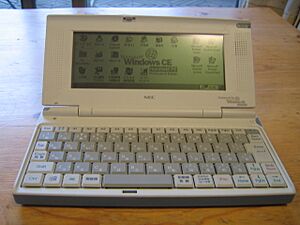
In 1990, NEC's new main office building, the "Super Tower," was finished in Shiba, Tokyo. NEC also worked with companies in China to make digital phone systems.
Even though NEC was the top PC seller in Japan, it faced more competition in the 1990s. In 1994, NEC bought Packard Bell to make desktop PCs for North America.
NEC also made another game console called the PC-FX in Japan. It stopped making video game consoles in 1998. However, NEC continued to supply important parts like CPUs and GPUs for other popular game consoles, including the Nintendo 64 and Dreamcast.
In 1999, NEC celebrated its 100th anniversary.
Modern Era and New Focus (2000–Present)
In 2000, NEC started a joint company with Samsung SDI to make OLED displays. In 2002, NEC Electronics Corporation became a separate company focusing on semiconductors. NEC also built the Earth Simulator Computer (ESC), which was the fastest supercomputer in the world from 2002 to 2004.
In 2004, NEC stopped making displays. In 2007, NEC and Nissan started a joint company to make lithium ion batteries for hybrid and electric cars. This company was called Automotive Energy Supply Corporation.
In 2010, NEC Electronics merged with Renesas Technology to form Renesas Electronics. This made them one of the largest semiconductor companies. In 2011, NEC formed a joint company with Chinese PC maker Lenovo for their PC business.
In 2012, NEC announced it would reduce its number of employees globally. This was due to economic challenges and slower growth in the smartphone market.
By 2013, NEC was the biggest PC server maker in Japan. In 2014, NEC was chosen to build a super-fast undersea data cable connecting the United States and Japan. This cable started working in 2016. NEC stopped making smartphones in 2015.
In 2018, NEC started a new company called NEC X in Silicon Valley. This company helps new technologies and business ideas grow faster. In the same year, NEC bought KMD, a large IT company in Denmark. This helped NEC grow its digital government business.
NEC sold its lighting business in 2019. As of September 2019, NEC is the largest supplier of AI surveillance technology in the world.
In 2020, NEC sold most of its professional display business to Sharp Corporation. NEC also decided to slowly stop its energy storage business.
In 2020, NTT, Japan's largest phone company, invested in NEC. This was to help NEC grow its 5G network business. In December 2020, NEC bought Avaloq, a company that makes digital banking solutions.
What NEC Does Today
As of July 2018, NEC has six main business areas: Public, Enterprise, Network Services, System Platform, Global, and Others.
Some of NEC's main companies around the world include:
- NEC Corporation of America
- Netcracker Technology
- NEC Europe
- KMD
- Avaloq
NEC Products
NEC makes many different products, including:
- NEC MobilePro – a small computer that fits in your hand.
- Electric vehicle batteries (made with Nissan).
- NEC mobile phones.
- NEC computer monitors and fax machines.
- Digital cinema projectors.
- Laptop PCs (like the Versa series).
- Desktop PCs (like the POWERMATE series).
- Car stereos and keyless entry systems.
Gaming Consoles
NEC has also made several game consoles:
- PC Engine (known as TurboGrafx-16 in the US).
- PC-Engine GT (TurboExpress in the US).
- PC-Engine Duo (TurboDuo in the US).
- PC-FX.
Personal Computers
NEC has made many series of personal computers, including:
- PC-6000 series
- PC-6600 series
- PC-8000 series
- PC-8800 series
- PC-9800 series
Microprocessors
NEC has also developed microprocessors, which are like the "brains" of computers:
- NEC V20
- NEC V25
Defense Products
NEC also makes products for defense, such as:
- J/TPS-102 self-propelled ground-based early warning 3D radar for the JGSDF.
- Broadband multipurpose radio systems.
- Parts for the Advanced Combat Infantry Equipment System (ACIES) for the JSDF.
Telephones and Communication Systems
NEC makes various phone and communication systems for businesses:
- NEC SL2100
- Univerge Blue (a cloud communication platform)
- Univerge SV9100, SV9300, SV9500
Supercomputers
NEC has built some of the world's most powerful supercomputers:
- 1983: Announced the SX-1 and SX-2 supercomputers.
- 2002: Introduced SX-6.
- 2002: Installed the Earth Simulator, which was the fastest supercomputer in the world for two years. It could do 35,600 gigaflops (billions of calculations per second).
- 2017: Announced the SX-Aurora TSUBASA computing platform. This platform helps with supercomputing, Artificial Intelligence, and Big Data analysis.
NEC's Achievements
NEC has made many important discoveries and inventions, including:
- The discovery of single-walled carbon nanotubes by Sumio Iijima.
- The invention of a widely used method for testing computer chips called MUX-scan design for test.
- The world's first test of a one-qubit rotation gate in solid state devices (important for quantum computing).
- For mobile phones, NEC was a leader in technologies like color displays, 3G support, and camera modules.
- Developed a facial recognition system that can identify people even when they are wearing medical masks.
- Released the first home video game system to use compact discs.
Sports Sponsorships
NEC has sponsored many sports events and teams:
- NEC was the main sponsor of the Davis Cup tennis competition until 2002.
- NEC sponsored the NEC Cup and NEC Shun-Ei, which are Go tournaments in Japan.
- NEC sponsored the English football club Everton from 1985 to 1995.
- NEC sponsored the Sauber F1 Team from 2011 to 2014.
- NEC also sponsored the Sahara Force India F1 Team and Racing Point in Formula 1.
- In 2013, NEC became a sponsor for PGA Tour Latinoamérica, a professional golf tour.
Sports Teams Owned by NEC
NEC has also owned professional sports teams:
- NEC Red Rockets (women's volleyball team).
- NEC Green Rockets (men's rugby union team).
NEC used to own the Montedio Yamagata football (soccer) team, but now it only sponsors them.
Images for kids
-
The European headquarters of Renesas Electronics Europe in Düsseldorf, Germany (formerly NEC Electronics (Europe))
-
NEC's Kobe system center
See also
 In Spanish: NEC Corporation para niños
In Spanish: NEC Corporation para niños


